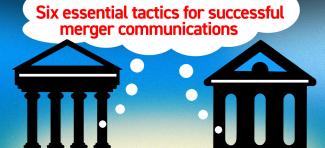
Bank Merger Communications: Six Essential Tactics
By Melissa Chefec, Business Development Manager
There are many reasons banks acquire other banks: to gain market share and grow deposits; to establish and deepen relationships with new customers; to expand their footprint to create new business development opportunities; to build scale to enhance product and service offerings.
As an agency specializing in bank merger communications for nearly 30 years, we offer the following six tactics to help support a smooth transition.
- Make the messages crystal clear.
Right from the start, customers need to know what will be changing for them, when it will happen and what they need to do (if anything). With direct mail as the primary, required communication channel, it can be smart to feature these critical points clearly and obviously in sidebars or callout boxes.
When customers need to take action before a specific date, be certain to highlight what they need to do in a way that is hard to miss. If no action is necessary, make sure to point that out, showing your customers that you are working to make changes easy for them.
All communications should include a phone number for questions and a link or URL where additional details can be found. A list of frequently asked questions to be posted to the website, recapping important messages and offering additional detail on specific topics is also a good practice.
Keep in mind that customers will not likely read every word, so keep communications focused, highlight the most salient information and strive to make the key points impossible to miss.
- Tell your customers what is staying the same.
Most people don’t like change, so consider focusing on things that are staying the same. This could include login credentials, branch phone numbers, hours and staff, fees and more. Continue to emphasize the product and service features that will not be changing to remind your customers why they chose them in the first place. Use this communications opportunity to deepen customer relationships by reinforcing the benefits of the product and service features they will retain.
- Over-communicate and use all available touch points.
In the case of merger communications, you can rarely over-communicate. Individuals respond to different types of communications and different channels or touchpoints, so we recommend you use many, including printed and digital approaches, to reach the most customers possible. Here are some specific suggestions:
- Direct mail provides customized and comprehensive information, as well as highlights of new opportunities.
- Email has become an important and credible way for companies to communicate timely information.
- Secure messages and banners within online and mobile banking are served during a critical point in time when customers’ attention is squarely focused on their accounts.
- A merger microsite can serve as a central repository and destination for comprehensive merger information. Direct “deep links” to specific pages on the microsite from prominent pages on your general corporate site and from other merger communications.
- Statement inserts or statement messages can also be an effective and, in some cases even targeted, tactic.
- Offer personal account information in your communications.
It’s only natural for customers to want to know what will impact them personally. Including the last four digits of the customer’s current account number(s) in your letter along with the new product they will get at conversion can provide reassurance to customers that you know who they are and the relationship they have with your institution. A chart can be used to list multiple accounts for the same customer and customized messaging provides the key features of their new accounts.
- Stay on brand.
Merger communications are an opportunity to make a first impression with new customers and at the same time to reinforce surviving brand promises, tone, and personality. Be mindful to keep your brand messages and promises consistent and paramount in all your customer touchpoints and communications. This is critical to support your overall company’s performance by helping to grow relationships with new and current clients while keeping attrition rates low.
- Timing matters when it comes to communicating change.
Most changes affecting customers, such as fee increases or product updates, must be communicated 30 days prior to the date the change goes into effect. But, in cases where customer action required, consider mailing even earlier than the 30-day requirement to allow more time for customers to respond.
With changes like new login credentials for online banking, notify customers closer to the effective date. Ideally the timing will be just right so customers don’t forget the details or lose track of the communication that included the pertinent information. For direct mail, this kind of information should mail approximately two weeks prior to the date the change goes into effect.
In short…
Through our many years of experience managing bank merger customer communications projects for large and small banks around the country, we’ve learned that utilizing these six tactics can help create change communications that are clear, effective and well-timed—and provide your new customers with a warm welcome and a smooth and positive customer experience.
MKP communications inc. is a New-York based marketing communications agency specializing in merger/change communications for the financial services industry.